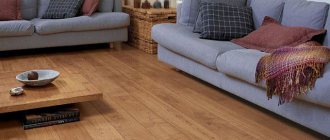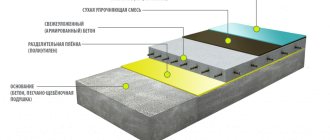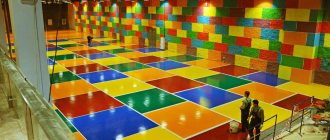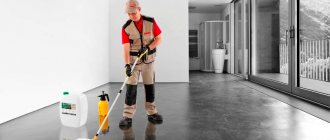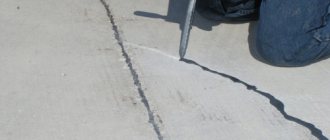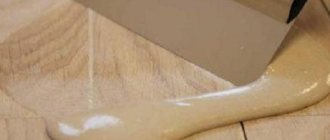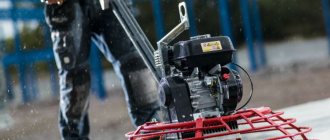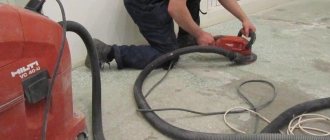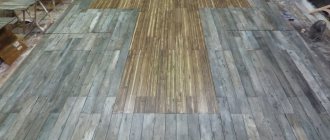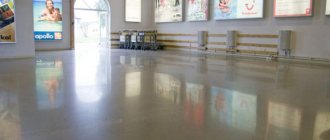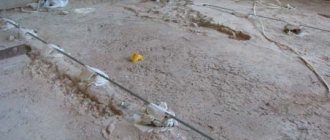Please rate the quality of the article. By the way, you will be the first! Rating:
0
X
Penetrating waterproofing for concrete is a mixture that makes the concrete surface waterproof. In other words, if you treat the bathroom floor with this composition, you can sleep peacefully. Your small local flood will not disturb the neighbors below. This is not a fiction, but a real effect from treating concrete with high-tech compounds.
Everyone is accustomed to thinking that waterproofing is the outer covering of the foundation with some kind of rolled waterproof material. But probably many simply do not know about such a new word in construction technologies as penetrating waterproofing. We will help you understand the principle of operation of this product, and also consider the technology of use.
It happens that when building a garage or a country house, we cannot provide for all the nuances. And so, in the new basement, where you wanted to store wine and beautiful jars of preserves on the shelves, a pool was formed in the spring. Optimists can rejoice at unplanned innovation. But the realists already realized that an important point had been missed. Need protection from groundwater. What to do? Digging up the foundation?
Helpful information:
- Ironing of concrete surface
- Concrete porch: step-by-step instructions
- Proportions of concrete for the foundation
- Anchors for concrete
- How much does a cube of concrete weigh?
- Waterproofing a bathhouse floor: brief and to the point
No need to dig anything. Just for such cases, a unique waterproofing composition for concrete has been created.
I want to see everything!
I want to see everything!
Penetrating waterproofing: what is it?
The name itself suggests that the substance must penetrate somewhere to protect against water. And it penetrates into those pores and microcracks that form inside the layer of cement-sand mixture during its shrinkage.
Some may doubt the effectiveness of such coverage. It is difficult to imagine what is not visible to the eye. But to dispel doubts, let's give a simple example. For almost half a century, deep penetration waterproofing impregnation has been successfully used when drilling oil wells to protect concrete structures from water and aggressive chemicals. By the way, drilling one oil well costs more than a hundred million rubles.
Let's look at the work of the waterproofing composition under a microscope. How can this solution, which looks like liquid cement, penetrate deep into a concrete wall or floor to a depth of 10 to 90 cm?
Firstly, simple laws of physics apply here. Under the influence of osmotic pressure, active substances are “drawn” into the thickness of concrete (the same laws apply when water is absorbed into a dishwashing sponge).
And secondly, chemical processes take place here. The substances of the mixture react with the calcium components of cement, where they form crystals. These crystals fill all pores, microcracks and do not allow water to pass through. Moreover, when the structure gets wet from the outside, the crystals grow and penetrate deeper.
The stronger the surface moisture, the more intense will be the penetration of the active components of waterproofing into the thickness of the concrete.
Waterproofing coating is available in the form of ready-made solutions or dry mixtures. It includes:
- high quality cement;
- sand;
- polymer additives;
- chemically active substances.
Although this product is not cheap, I would like to justify its cost and add a few more bonuses. This is what distinguishes penetrating impregnations from the usual roll coating:
- Penetrating coating makes concrete 10% stronger.
- The number of cycles of temperature changes that a concrete base can withstand increases to 100.
- Despite being waterproof, the structures remain breathable (steam and air pass through the pores without hindrance). This helps prevent mold growth.
- The product reliably protects the internal metal frame of reinforced concrete from corrosion.
- The coating can be used externally during the construction phase or internally during renovation work.
- The service life of the composition is equal to the life of concrete. And since the composition increases the strength and durability of the base, the service life of the waterproofing increases accordingly.
Required Tools
Crushed stone Cement Plywood Roofing felt Protective film Sand Adhesive tape (scotch tape) Primer Gravel Bituminous mastic Show all
Floor waterproofing in private housing construction is a real necessity. If such an operation is not performed, over time the foundation of the home and its entire structure as a whole will begin to experience the negative influence of soil water.
- 2 Waterproofing the floor base on the ground
- 3 We protect concrete structures - two effective options
- 4 Protecting a wooden floor from moisture is a simple operation
- 5 How to protect kitchen floors?
In what cases is waterproofing for concrete used?
To answer this question, let's look at the problem from the inside. Despite all its “reinforced concrete” properties, concrete quickly becomes brittle when exposed to moisture, aggressive liquids, mold and mildew. The internal metal frame rusts and collapses. Obviously, in order to preserve the building for many years, it is necessary to prevent the access of water inside.
So we got the answer. Wherever there are problems with high humidity in the room or where airtightness is required, waterproofing impregnation can be used. It protects the foundations of houses well from moisture. Allows you to keep basements dry. It is used to seal wells, swimming pools, and bathroom floors.
Waterproofing materials for log houses
Such floors have a huge number of advantages. For example, wood is certainly much more environmentally friendly than concrete. If you choose high-quality materials, you don’t need to think about spending on additional flooring.
We invite you to familiarize yourself with the Apricot Plum Tree
In addition, the tree has other advantages:
- Retains heat much better.
- Does not create increased load on the supporting structures of the house.
- If one of the boards is cracked or damaged, it can be easily replaced with a new one without replacing the entire structure.
- If you are tired of the shade of the floor, then the wood can be repainted without any problems. It will not lose its aesthetic appearance.
Healthy! If you need to wait almost a month after pouring concrete, then a wooden floor can be used immediately after installation.
But there are also disadvantages. For example, if the house does not have a basement floor, then you will have to make a double floor. First, the so-called subfloor is laid (for this you can use boards of no better quality), then comes the insulation and finishing layer (you need to use the best materials for it).
Healthy! If a concrete screed costs about 230 rubles per “square”, then a tree will cost at least 1,000 rubles. Moreover, there is always a risk that you bought low-quality material. In addition, to lay such a floor you need to have at least minimal carpenter skills or you will have to hire a craftsman.
You will also have to take care of impregnating the wood with specialized compounds that will increase fire and moisture resistance. But even this may not save you from insects and rodents, which will gradually destroy the structure. Thus, wood has a shorter service life than concrete.
Healthy! Over time, the wooden floor begins to creak. This is annoying, especially when you go to drink water at night and wake up everyone in the household.
It is also worth paying attention to such disadvantages as:
- Wooden floor is higher than concrete. During the installation process you will have to use logs. These additional structures make the installation process more labor-intensive and expensive.
- The tree is prone to drying out. The boards may crack.
- Wood should not be used for rooms with high humidity. The material will quickly begin to rot.
Therefore, when installing a floor, you need to take into account not only the characteristics of the building material, but also the type of room.
The most common material is TechnoNIKOL waterproofing for foundations. It is produced in the form of rolls that are rolled out onto mastic, without the use of gas burners for heating.
The laid waterproofing between the foundation and the log house has two purposes:
- Anti-filtration. Designed for aggressive environments and capricious soils. There are often large amounts of chemical elements dissolved in the soil, which can affect the composition of the foundation and have an unfavorable effect, slowly destroying it.
- Anti-corrosion. The condition of the wood directly depends on it - the waterproofing layer should not allow rot and, as a consequence, other damage.
Let's consider the first option, which must be laid before pouring concrete. Then there will be no meaning anymore. The owner must understand this even at the stage of determining the soil and foundation model for construction.
1. When the ditches and formwork are ready, add a layer of sand to the bottom and compact it thoroughly, pouring water several times. Then crushed stone is poured on top of it and compacted as well. In total, both layers should not be less than 30 cm.
And the water itself will not stay in it for long. This should be taken into account by owners whose houses are located near industrial enterprises, car parks, farms and other things. Waste products will definitely end up in the soil, and who knows how it will behave when it meets the base.
2. The second option is familiar in understanding - the wood should not come into contact with water. Waterproofing a log house from the foundation is done by creating layers between two different surfaces. This process has several methods - coating, glued and gasketing.
- For the first, bitumen mastic or liquid resin is used. Having brought them to the state of paint, the prepared foundation, freed from the formwork, is coated very carefully, without leaving any white spots. The work is carried out in several layers after the previous one has dried.
- The next method is glued. For it, roofing material is used, which is also heated and tightly applied to the surface of the foundation. You can't get by with just one layer. Two are mandatory, three depending on the condition of the soil.
- The third method, in which waterproofing the foundation for a log house will last almost forever, involves the use of progressive means of protection from the current industry.
We invite you to familiarize yourself with Blue Orchids. How to paint an orchid blue
Sheets of polystyrene foam, expanded polystyrene, or an extruded derivative material are placed in a compacted ditch along the perimeter of the walls of the entire foundation. You can attach them “to the core”; anyway, the filling and the reinforcement will press as it should. In this way, the entire base is processed.
But before this, the surface must be dried from moisture and tarred, but while the bitumen is hot, it is convenient to glue the slabs. Needless to say, the first crown in this case is also coated.
Before you start building a wooden structure, you should take care of the dry and protected foundation of the house. This is the primary insulation of the log house from moisture and preservation of its durability. It's worth doing some careful work here.
Waterproofing the base of a wooden house foundation is carried out according to the following scheme:
- Rolled roofing felt is placed on the compacted cushion.
- Fill the top with hot bitumen (a thin layer).
- A second layer of roofing material is applied.
- Strengthened with a small layer of cement mortar.
This insulation will allow water to be cut off from the ground. They will not touch the base of the foundation, which means they will not be able to harm the elements of the future wooden house.
The second stage creates vertical waterproofing of the foundation of the building. It is applied to the flat surface of the entire base of the house. Insulation is carried out by coating the base walls with hot bitumen or mastics based on liquid rubber or liquid glass. It is better to apply in several layers, leaving no free or untreated space.
The third step is waterproofing between the first crown and the foundation of the building. It is not difficult to create if you follow all the recommendations of experts. After all, the gap that appears between the first crown and the foundation of the house can be repaired quite efficiently and firmly with your own hands. Moreover, modern material manufacturers produce many high-quality insulators.
It’s easier and cheaper to use proven materials that have been used for many decades. This is wet moss placed into the cracks in several layers. But you can also seal the holes with more modern materials, such as foam, which, when hardened, form a protective barrier that does not allow moisture to penetrate inside the structure.
Types and types of waterproofing
To understand the benefits of penetrating compounds, let’s take a short excursion into the world of construction technologies. Let's remember the main types of waterproofing.
Table. Methods of waterproofing.
| Methodology | a brief description of |
| Coating waterproofing | The main types are hot bitumen mastic, polymer resins, bitumen-rubber mastics. Materials are applied to well prepared and cleaned surfaces. Protect walls, floors, and ceilings from water penetration. The compounds crack and lose elasticity due to temperature changes and vibrations. Usually after 3-4 years the coating requires replacement. |
| Adding additives | According to the principle of action, chemical additives that are used when mixing concrete are similar to penetrating waterproofing. They fill the pores in the concrete as it dries. The resulting waterproofing concrete is used for screeds and filling voids between slabs. |
| Pasted insulation | It is carried out by gluing roll materials. They are applied in 3-4 layers. Used for external water protection of foundations, walls, roofs. Polymer materials can be laid on top of old coatings. They are resistant to aggressive liquids, do not rot, but can be easily damaged by mechanical stress. |
| Spray type | You can call this coating liquid rubber. The polymer-bitumen emulsion is applied with a special spraying tool. The liquid composition will get into all hard-to-reach places and fill all pores. The coating can only be used for outdoor work. The sprayed film needs protection from mechanical damage. |
Let us not diminish the merits of these methods of protection. Each composition can be optimal for a specific case. When choosing a suitable material, you need to consider all the pros and cons.
Installation of a concrete floor on the ground
Concrete flooring directly on the ground is one of the easiest and most common ways to pre-coat the floor of a private home. Most often, this method is used in houses that have a strip foundation. This method of arranging the floor is relevant only for structures that are heated in winter. The work is carried out in several stages and includes the following operations:
- Filling the prepared surface with sand, crushed stone or expanded clay;
- Pouring concrete solution;
- Waterproofing layer;
- Cement strainer.
Since in this case the concrete screed is made directly onto the ground, there is a high probability of groundwater penetration. Waterproofing a concrete floor over the ground must be done hermetically; polyethylene film in several layers or roofing felt is ideal for this purpose. To achieve maximum tightness of the joints, the insulating material is laid overlapping, and all joints are carefully taped.
Roll waterproofing
Scope of application, pros and cons
“Everything is relative,” said Einstein. Same with waterproofing. There can't be pros without cons. Let's move on to theory and break down all the advantages and disadvantages of liquid waterproofing with deep penetration function.
So, the pros:
- no need to dig up the foundation for processing;
- the solution can be applied with a simple brush like paint;
- the composition modifies concrete: makes it water-repellent, increases strength, frost resistance;
- after treatment, concrete retains its breathable properties;
- no need to dry the surface before applying impregnation;
- the product is safe for humans;
Disadvantages (or rather difficulties) that accompany construction work on applying a penetrating mixture:
- If the wall being treated is no longer new, you need to very carefully clean the surface to free clogged pores. You will need to completely remove the existing coating (plaster and paint).
- For the composition to work, the base must be thoroughly moistened. The solution is applied only on wet concrete. Without this, active additives will not penetrate deep into the pores.
- Large cracks, as well as seams, need to be glued with special paste-like compounds.
- The activity time of the chemical components of the mixture is limited. It is 30 minutes after preparation.
- Work must not be carried out at sub-zero temperatures.
- The drying process also requires compliance with certain conditions. The treated surface is covered with film and periodically moistened for another 2 weeks.
- The coating is not used for brick, cellular concrete, or stone surfaces.
Someone will say: “Good luck guys! I’ll go get some roofing felt.” But what if you imagine that such concrete will last at least 100 years, and your great-great-grandchildren will swim in the pool you built? Or maybe after thousands of years during excavations they will find your ideal wine cellar and admire the talent of the builder? Well, no, thanks! What kind of roofing material!
Let us give examples of industrial applications of penetrating compounds to dispel your last doubts. Here's where penetrating waterproofing is used:
- designs of subway structures, tunnels, bridges, thermal power plants, overpasses;
- berths, piers;
- water treatment and hydraulic structures;
- sewerage systems, including settling tanks, ponds, aeration tanks;
- containers for drinking and technical water supply;
- foundations, walls, floors, ceilings of buildings and structures;
- dams, tunnels, mines.
Review of popular brands: my rating
And now about the main thing. How not to buy simple cement instead of a unique powder. Unfortunately, the construction market is saturated with fakes. Therefore, experienced craftsmen strongly do not recommend buying expensive materials in dubious places at a suspicious discount. Give preference to chain stores that cooperate with large manufacturers. They will be able to show product quality certificates, as well as documentation containing information about the manufacturer.
Penetron
The brand has been known in the construction market for half a century. Penetrating waterproofing Penetron has the following characteristics:
- It is used to insulate swimming pools, garages, bathrooms, foundations, and basements.
- The cost of the dry mixture is about 330 rubles. for 1 kg.*
- Product consumption is 1 kg per 1 sq. m (when applied in 2 layers).
- The solution is prepared immediately before application. The proportion consists of 1 part water and 2 parts dry powder. When mixing, you need to pour the powder into the water, and not vice versa.
- The temperature of the treated surface should not be lower than +5 degrees Celsius.
* Prices are current for the month of May 2020.
Penecrete and Penebar as an addition to Penetron
Penetron's companions allow you to create ideal waterproofing. Penecrit is a dry mixture. It is diluted with water to form plasticine, and the seams, cracks and crevices are coated with it.
Before applying any penetrating composition, the surfaces of the seams must be carefully prepared. First, they need to be trenched to a depth of 45 mm and a width of 25 mm. Then thoroughly remove dust with a brush and moisten to create adhesion.
Penebar is sold in rolls. This is a solid black sticky cord. It consists of composite materials that expand in volume upon contact with water. This ability is used to fill seams more densely.
Briefly, the installation technology looks like this:
- the seams are thoroughly cleaned of dirt and cement;
- A composite cord is laid into the resulting grooves. The paper layer is first removed from the surface. The ends of the strips are cut obliquely and joined end-to-end. To prevent the tourniquets from moving, they are secured with staples or pegs;
- after abundant wetting, the tourniquet turns into a waterproof gel and increases in volume by 3 times. The composition tightly fills all cracks and crevices.
Penebar can be laid on damp material. But it is necessary to exclude use on surfaces with standing water and at temperatures below +5 degrees Celsius.
Lakhta
One of the best products in the rating of penetrating waterproof insulation among Russian manufacturers. In terms of quality, Lakhta is compared to Pentron.
Waterproofing is a one-component mixture of cement, quartz sand and special additives. Thanks to chemical processes, the solution merges with concrete into a single whole. The penetration depth is more than 10 cm. Dry powder consumption is 1.2 kg per 1 sq.m. This is the maximum consumption when applied in 2 layers on a rough surface. When used on a smooth surface, consumption is reduced to 0.8 kg per 1 sq.m.
The cost of a bag weighing 25 kg is approximately 5150 rubles. (or 207 rubles per kg)*. The material is also sold in packages of 5 and 10 kg.
The impregnation agent is used in industrial and individual construction. It is used to treat swimming pools, garages, balconies, basements, and drinking water tanks.
Structures treated with Lakhta waterproofing become resistant to alkalis, petroleum products, and other aggressive reagents.
The composition cannot be used for the following materials:
- super-dense concrete;
- plasters of various types (lime, gypsum, cement);
- highly porous and block structures.
Calmatron
Calmatron has a wide range of applications. This is due to its real effectiveness and deep penetration into structures.
Calmatron has the following characteristics:
- The service life of the coating is from 20 to 50 years. It depends on the aggressiveness of the environment.
- Penetrates to a depth of 15 cm.
- Consumption – 1.6 kg of dry mixture per 1 sq.m.
- Increases the strength of concrete surface by 30%.
- It can be added when preparing a cement-sand mixture or coated with finished structures.
- Contains safe additives that allow the product to be used in drinking water containers.
- Reduces the level of penetration of radionuclides by 5 times.
- Resistant to petroleum products, diesel fuel and mineral oils.
Finishing work on walls, floors and ceilings treated with penetrating waterproofing can begin only 1 month after impregnation.
The Calmatron line contains self-expanding strands for seams and elastic polymers for insulating surfaces prone to deformation.
Crystallisol
Kristallizol can be called a leader among domestic manufacturers. The Russian brand of the GidroStroyKomplekt plant has proven itself:
- quality products;
- a wide range of items;
- positive customer reviews.
Kristallizol has all the characteristics of high-quality waterproofing. The affordable price makes it popular among buyers.
Crystallisol was used in the treatment of such objects as the Moscow metro, the gateways of Volgograd, the Faceted Chamber of the Kremlin, and the Triumphal Arch on Kutuzovsky.
In everyday life, Crystallizol products are used in garages, bathrooms, wells, swimming pools, house foundations, and basements.
Waterproofing the floor in a bathhouse with your own hands
When building a bathhouse, it is very important to find the right design solution for draining water outside the room. Whatever material is chosen for the flooring, it is very important that the surface is warm both in summer and winter. Wooden floors are considered the most comfortable and warm, but with constant exposure to moisture they will quickly begin to rot and fail. Concrete flooring is more resistant to water, but its production will require a lot of time and effort.
Waterproofing a concrete floor in a bathhouse must be carried out in accordance with all building codes and regulations - this will help to avoid excessive dampness and deformation of the structure. All work can be divided into the following operations:
- A cement screed with a thickness of at least 2 cm is applied to the concrete surface;
- The floor plane is carefully prepared; there should be no irregularities, bumps or other deformations on it. It is also necessary to clean it from contaminants such as oil stains or paint stains;
- The floor is evenly covered with bitumen mastic in several layers, the directions of the layers must be alternated;
- Rolled waterproofing is laid on top of the mastic; you can use roofing felt, roofing felt or thick polyethylene.
After all the work is completed, you can begin laying the flooring. Coniferous wood is most often used, since it is most saturated with resin and is not subject to rapid decay.
Protecting the floor from water
Liquid waterproofing for concrete
Liquid waterproofing is a ready-made composition for treating concrete. Compared to dry mixtures, ready-made impregnations have some advantages. Let's highlight the main ones:
- When applied, a monolithic rubber-like film is created that adheres to every millimeter of the rough surface.
- Liquid rubber can be used on uneven surfaces.
- Application using special sprayers allows you to treat large areas in a short time.
The combined use of penetrating impregnation and liquid rubber makes concrete invulnerable to water.
There are 2 types of liquid coating. Let's see how they differ.
| Name | Characteristic |
| Liquid rubber |
|
| Liquid glass |
|
The nuances of using liquid waterproofing for concrete
Liquid rubber is used in cases where other materials are ineffective or when it is necessary to provide protection against moisture in hard-to-reach places. It is also used in cases where the surface is prone to cracking.
The average cost of 1 kg of domestically produced solution is 150 rubles/kg.* At the same time, the consumption is 2.6 kg per 1 sq. m. with an application layer of 2 mm. For an area of 10 sq.m. you will need to spend 3900 rubles.
An important point is that this liquid is difficult to apply correctly if you do not have experience. In this case, you will need the help of professionals with tools. The application layer in 1 approach should be no more than 2 mm.
Other nuances of using liquid polymer solutions:
- the surface needs careful preparation;
- You cannot add additional water and cement to the mixture;
- use is not allowed at temperatures below +5;
- Do not apply to icy surfaces.
And finally. The applied layer of liquid glass or rubber is very easy to damage. Therefore, such a coating itself needs protection, but from mechanical influences.
* Prices are current for the month of May 2020.
Waterproofing materials for log houses
Protection from moisture is not only required for the foundation - the living space also needs it.
For this purpose, a kind of pie is laid - in addition to insulation, layers of hydro- and vapor barrier are laid both inside and outside. However, this is intended for such residential log houses that do not require cladding. The bathhouse is the “wettest” room. Moreover, all its premises are in constant contact with steam. But it cannot be impregnated, with the exception of particularly advanced compounds or waste oil.
The height of the clean coating in this case should be at a decent distance from it. Impregnations to ensure that the waterproofing of the bathhouse frame is up to standard are mandatory, but only with the appropriate markings, otherwise it will not improve anyone’s health.
The waterproofing of the foundation itself, as well as the protection that allows you to keep the log house dry, is carried out by several types of materials:
- Hot bitumen.
- Anti-corrosion coating.
- Penetrating mastics.
Of course, each insulator is selected in accordance with the parameters of the building material.
Thus, the log house is treated with special mastics, which are applied to each log or timber separately. And then also on a completely finished structure, as additional protection. If special materials are not available, you can coat the logs yourself with used machine oil to protect them from rotting and damage by beetles. Resins are often used for protection, which serve as an excellent insulator.
The foundation of a wooden house between the base and the first crown is best treated with bitumen mixtures. This will provide good protection and will look more natural. But often such insulation is performed using penetrating mastics, which are produced in liquid form. True, after processing you should not forget about the gap that appears when the log house is laid on the base of the house.
Characteristics of coating waterproofing for concrete
Many inexperienced craftsmen may get confused, mistaking coating waterproofing for penetrating impregnation. This is normal, because these compositions are similar in appearance. But here are their differences:
- The penetrating agent enters through the pores deep into the structure, and the coating protects only the surface from water. It penetrates inside only to a distance that is sufficient for a strong grip.
- Penetrating waterproofing is applied in 2 layers, and coating compounds have a thin coating.
Here are the important properties of polymer waterproofing:
- enhanced adhesion to the porous structure of the material;
- water-repellent properties;
- elasticity, which is created by adding polymer components.
The coating material is chosen for each specific situation. It is important to read the instructions before purchasing. It should say on which side the product can be applied. The composition must be resistant to water pressure. If you choose the wrong one, it will simply peel off and fall off. Accordingly, it’s money down the drain.
Reasons to waterproof a concrete floor
Concrete screed is a popular base for decorative flooring. But condensation and water vapor accumulated on its surface can reduce the aesthetic qualities of linoleum, parquet and even tiles, and also lead to a number of negative consequences.
High-quality waterproofing of a concrete floor will allow:
- protect the decorative coating from swelling or peeling off;
- prevent the appearance of mold and mildew around the perimeter and on the walls of the room;
- protect the interior from excess moisture;
- prevent the destruction of the foundation in private construction.
Features of waterproofing paint for concrete
We have already looked at different waterproofing materials. Now you can consider yourself an expert in the field of concrete waterproofing. But to complete the picture, one more type should be added. This is a special water-repellent paint.
The main advantage of the paint is that it can be applied with a brush without the help of professional equipment.
For information: paint can be one-component or two-component. One-component enamels are already ready for use. Their hardening occurs under the influence of moisture from the air. And two-component mastics are supplied in 2 packages. Their contents must be pre-mixed. The setting of the protective layer occurs due to a chemical reaction.
Enamel is often applied to the inside of swimming pools or water storage tanks. It doesn't look like cement at all. The paint has pleasant colors and a smooth surface. Acrylic mastics lend themselves well to tinting.
This coating can be applied to the facades of houses. The paint easily smooths out small cracks and fills construction joints. It can withstand both negative and positive water pressure.
Coating waterproofing device
Mastics are not as picky about a perfectly flat surface as rolled material, since due to their structure they themselves perfectly level the base. The main thing before starting work is to prevent the presence of moisture on the surface of the floor and walls.
Stage 1. Prime the surface of the floor and walls (20 cm).
Stage 2. Apply waterproofing tape to the joints, and insert rubber liners in places where pipes are inserted.
Stage 3. Apply mastic to the floor and primed walls in several layers. Each layer must be completely dry. Also, do not dust or pour water onto the drying composition.
After completing all the steps, you can apply a decorative coating on top.
